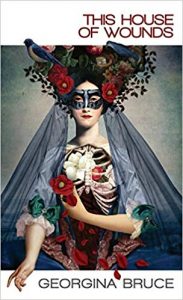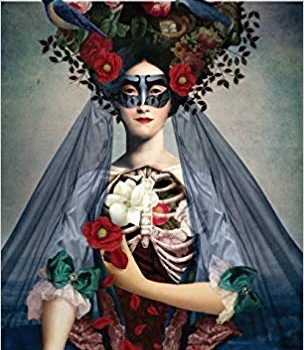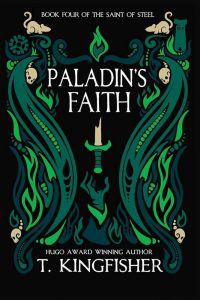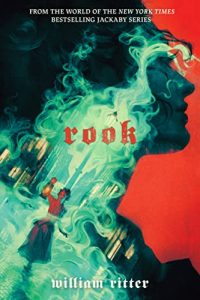Paula Guran Reviews This House of Wounds by Georgina Bruce
 This House of Wounds, Georgina Bruce (Undertow Publications 978-1-988964-09-6, $27.99, 248pp, hc) June 2019. Cover by Catrin Welz-Stein.
This House of Wounds, Georgina Bruce (Undertow Publications 978-1-988964-09-6, $27.99, 248pp, hc) June 2019. Cover by Catrin Welz-Stein.
Georgina Bruce’s searing debut collection contains 16 superbly written, often surreal stories of misogyny, blood, anger, agony, and abuse. Bruce’s stygian tales are technically accomplished, but also powered by a profound depth of feeling. They often compel and overwhelm at the same time. Like the cover art by Catrin Welz-Stein, This House of Wounds is both beautiful and horrific.
Bruce starts off with the devastating “The Lady of Situations”. Original to the volume, it’s woven – as many of these stories are – of dreams, nightmares, memory or the lack of it, and fear. Painful, disorienting shards accrue until the reader has a sense of an overall story.
She follows with another original, “Red Queening”, a masterful mix of bloody Alice-in-Wonderland allusion and Keirnanian – yet utterly original – relationship portraiture/examination/illustration. Two other originals are also included. “The Shadow Men” is a dark fairy tale of Queen Beast, her lost sister, shadows, and angry men who once were kings. In “Kuebiko”, Raewyn returns to a house (or art installation) her mother has left her: “The House of Wounds. Every doorway a knife stab.” Another lost sister, another lacuna of memory, a distant man/mate the narrator hates: these are themes Bruce uses over and over.
In “The Book of Dreams”, Kate has survived an accident she cannot recall that has left “an absence” in her mind: “A dark matter. A black hole with its chaotic corona, an event horizon over which tumbled thoughts and memories and intentions.” The narrator of “Dogs” appears to be more frankly insane than Bruce’s other characters, but: “They think I’m crazy, but I just forgot. Anyone can forget.” Mortimer Citytatters, a storytelling crow in “Crow Voodoo” writes scathing letters for Jenny to inflict on her soldier beau Robin, who sadistically enjoys the missives. Jenny bears the crow a daughter, and a broken Robin returns to marry her. The daughter has much to learn.
The titular character in “Wake Up, Phil” is a marijuana-smoking “sci-fi” writer who wears Hawaiian shirts, an obvious reference to Philip K. Dick, whose 1960s style of science fiction is invoked in this hallucinogenic story of pharmaceutical mega-corporations, in which Laura Harrison may or may not be a pawn.
In “The Art of Flying”, Trucker Maggie “flies in the night. It’s like swimming a breaststroke through the air.” She returns to Earth and worries about her flight. Neither religion nor medicine offer answers. In “The Seas of the Moon”, Siobhan tries to escape a destiny of drudgery and motherhood on the small island of her birth, without success. Years later the sea brings her something she thought lost.
The other stories in This House of Wounds are somewhat more accessible. In “The Queen of Knives”, Daddy thinks Eva is “just a child. A little girl, for God’s sake.” Mummy knows to keep the knives locked up. The Other Eva promises to tell the girl the stories: “But their true telling is in blood. You must have a blade if you want to speak the language.”
“Cat World” is similarly unambiguous. We meet two orphaned young sisters who live in a vicious future world in which Travel Gum can provide a short hallucinogenic respite to Cat World. This world – where business trips to the Moon are as common as destitute children and wired Dreemy People play a vague but sinister role – is also shared by (at least) “The Lady of Situations” and “The Book of Dreams”. Oh, the elder girl, disappears and Little One is left to fend for herself. Book, another girl, “saves” her by introducing her to Mr. Cow and his house of child prostitution.
Although surreal, “Little Heart” is also among the more easily understandable. Anna, a woman who likes to break things, was traumatized as a child after seeing her mother, an actress, in an “inappropriate” film. Adult Anna, after her mother’s death, feels compelled to watch the movie again. Not as surreal, but equally apparent is “The Art Lovers”. Paul, a British art student traveling in Europe, sketches an imagined woman and becomes obsessed with the image. Living women don’t measure up to this “perfect woman, the woman who was the embodiment of his art” and, of course, real women suffer for it.
Compared to most of the other stories, “Her Bones in the Trees” is more traditionally narrative – if your idea of “traditionally narrative” is a David Lynch movie.
“White Rabbit”, the final story in the collection, won the 2017 British Fantasy Award for short fiction. You could say it is about grief and how the living can deteriorate after the death of a loved one, but that would not do this lovely, frightening story justice.
This House of Wounds may be a challenging read in many ways, but it is well worth any demands it may make.
Paula Guran has edited more than 40 science fiction, fantasy, and horror anthologies and more than 50 novels and collections featuring the same. She’s reviewed and written articles for dozens of publications. She lives in Akron, Ohio, near enough to her grandchildren to frequently be indulgent.
This review and more like it in the August 2019 issue of Locus.
 While you are here, please take a moment to support Locus with a one-time or recurring donation. We rely on reader donations to keep the magazine and site going, and would like to keep the site paywall free, but WE NEED YOUR FINANCIAL SUPPORT to continue quality coverage of the science fiction and fantasy field.
While you are here, please take a moment to support Locus with a one-time or recurring donation. We rely on reader donations to keep the magazine and site going, and would like to keep the site paywall free, but WE NEED YOUR FINANCIAL SUPPORT to continue quality coverage of the science fiction and fantasy field.








